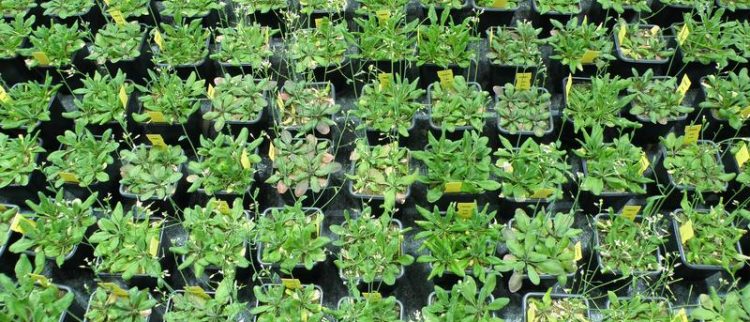Small Genetic Differences Turn Plants into Better Teams

Small genetic differences improve teamwork: Systematic crossing of wallcress varieties in a UZH greenhouse. University of Zurich
The ongoing worldwide loss of biological diversity is one of the most pressing challenges humankind currently faces. Biodiversity is vital to humans not least because it supports ecosystem services such as the provision of clean water and the production of biomass and food.
Many experiments have shown that diverse communities of organisms function better in this regard than monocultures. “In mixed communities plants engage in a kind of division of labor that increases efficiency and improves the functioning of the community as a whole,” explains Pascal Niklaus from the Department of Evolutionary Biology and Environmental Studies of the University of Zurich.
Nevertheless, modern agricultural practice mainly relies on plant varieties that are genetically uniform, since they make it easier to grow and process crops. The benefits of diverse communities therefore remain untapped, also because the underlying mechanisms are not yet fully understood.
“Despite intensive research, we currently don’t know which properties make plants good players in such mixed teams,” says Samuel Wüst, main author of the study.
Plants grow better in mixed teams
The two researchers addressed this question by combining modern genetic and ecological approaches. As a test system, they focused on common wallcress (Arabidopsis thaliana), a small crucifer that is genetically well documented. They used systematic crosses of varieties of these plants, which were grown in pots in different combinations. After a few weeks, the researchers weighed the resulting biomass, which allowed them to compare the growth of the plants. As expected, pots with mixtures of different crosses were indeed more productive on average.
Small genetic differences improve yield
Using statistical analyses, the researchers then related the yield gain in mixed communities to the genetic makeup of the crosses. The genetic map they obtained in this way enabled them to identify the parts of the genome that made the combination of plants good mixed teams. They found that even the smallest genetic differences between plants were enough to increase their combined yield.
“We were very surprised that complex and poorly understood properties such as the suitability to form a well-performing mixture had such a simple genetic cause,” says Samuel Wüst. He thinks that their method may help to breed plants that are good team players and thus yield more crops. “Our insights open up completely new avenues in agriculture,” adds Wüst.
Samuel Wüst, PhD
Department of Evolutionary Biology and Environmental Studies
Research Priority Program “Global Change and Biodiversity”
University of Zurich
Phone: +41 77 479 28 50
E-mail: samuel.wuest@ieu.uzh.ch
Prof. Pascal Niklaus, PhD
Department of Evolutionary Biology and Environmental Studies
Research Priority Program “Global Change and Biodiversity”
University of Zurich
Phone: +41 44 635 34 13
E-mail: pascal.niklaus@ieu.uzh.ch
Samuel E. Wuest & Pascal A. Niklaus. A plant biodiversity effect resolved to a single chromosomal region. Nature Ecology & Evolution. November 5, 2018. DOI: 10.1038/s41559-018-0708-y
https://www.media.uzh.ch/en/Press-Releases/2018/plant-teams.html
Media Contact
All latest news from the category: Life Sciences and Chemistry
Articles and reports from the Life Sciences and chemistry area deal with applied and basic research into modern biology, chemistry and human medicine.
Valuable information can be found on a range of life sciences fields including bacteriology, biochemistry, bionics, bioinformatics, biophysics, biotechnology, genetics, geobotany, human biology, marine biology, microbiology, molecular biology, cellular biology, zoology, bioinorganic chemistry, microchemistry and environmental chemistry.
Newest articles

Properties of new materials for microchips
… can now be measured well. Reseachers of Delft University of Technology demonstrated measuring performance properties of ultrathin silicon membranes. Making ever smaller and more powerful chips requires new ultrathin…

Floating solar’s potential
… to support sustainable development by addressing climate, water, and energy goals holistically. A new study published this week in Nature Energy raises the potential for floating solar photovoltaics (FPV)…

Skyrmions move at record speeds
… a step towards the computing of the future. An international research team led by scientists from the CNRS1 has discovered that the magnetic nanobubbles2 known as skyrmions can be…





















